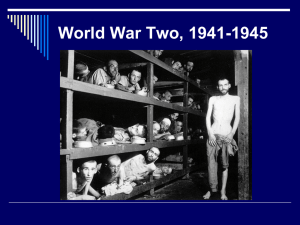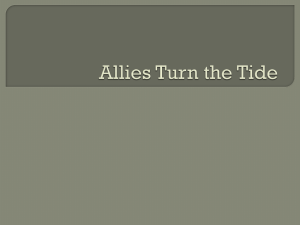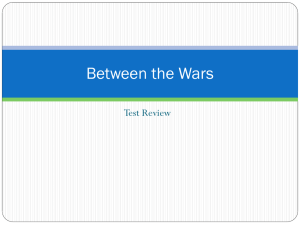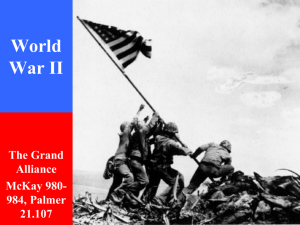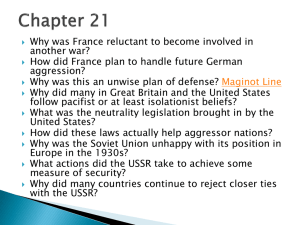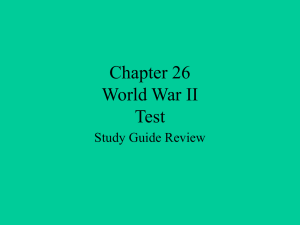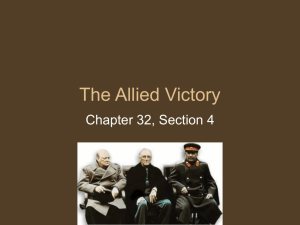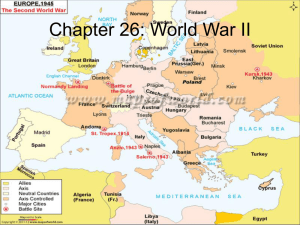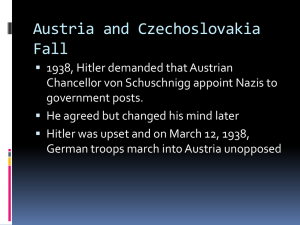World War II European Theater
advertisement
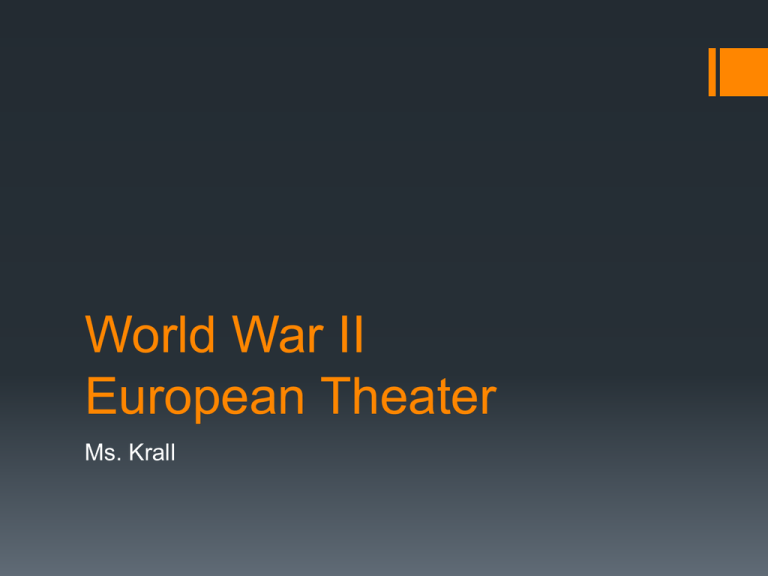
World War II European Theater Ms. Krall Welcome Back! Bell Ringer- Complete Pacific Battles Review sheet with your neighbor. Battles Quiz- Thursday! Start of the War… September 1, 1939 Hitler invades Poland. On hand 98 divisions, 1.5 million available for action. Had also 9 Panzer divisions. Each one had 328 tanks, 8 support battalions and 6 artillery batteries. Uses the tactic “blitzkrieg” or lightening War. End of September, German Army had control over the country. By November, Stalin invades Finland. European Front Invasion of France From fall of 1939 to Spring of 1940, war in Europe was known as the “Sitzkreig” or sitting war. Attack begins in May. By June, Allied forces are evacuated from French town of Dunkirk to England (Operation Dynamo.) Paris is occupied June 14, 1940 During this period, Hitler plans invasion of France through Belgium. Goal was to reach the English channel and force France to surrender. Southern part of France was controlled by a puppet government (“Vichy France”) and led by Marshal Henri Petain. Was pro-German. Welcome Back… Bell Ringer…. What is Sitzkreig? What is Blitzkreig? What was the name of the planned evacuation of Allied troops? What was the planned invasion to invade England? The Battle of Britain “Operation Sea Lion” The German Luftwaffe had 2,800 aircraft, which outnumbered the Royal Air Force (RAF) four to one. August 1940, Germans begin to bomb Southern England. Objective was to land 160,000 German soldiers along a forty-mile coastal stretch of south-east England. Hitler hoped England would accept German domination of Europe. Postpones invasion until British air force could be destroyed. The “Blitz” In Sept. Germans begin the “Blitz” and shift their bombing to London and abandon invasion. On the first day of the Blitz, 430 citizens were killed. The German bombers returned the next day and a further 412 died. Between Sept. 1940May 1941 two million houses (most in London) were destroyed and 60,000 civilians were killed. Seen as a moral victory for the Allies. Eastern Front Invasion of the Soviet Union “Operation Barbarossa” Stalin did not believe an invasion would occur until 1942, when both England and France would be defeated. Total of 3400 tanks and 3 million men used in the invasion. Stalin uses “scorchedearth” policy. Outcome of Hitler’s Lebensraum policy to create a greater Germany. Attack begins June 22, 1941 By August, Germans advanced to Leningrad (siege will last over 2 years.) By October head towards Moscow. Mediterranean Front Invasion of North Africa Italy declares war on the Allies in June 1940. Mussolini moves troops stationed in Libya to launch an attack on British forces in Egypt. Battles between Afrika Corps and British forces continue until the US landing of forces in North Africa in Nov. 1942 (Operation Torch.) creating a three front war. The British were able to launch a counteroffensive and take Libyan territory in January 1941. As a result, Hitler sends General Erwin Rommel (Desert Fox ) to lead the Afrika corps. By May 1943, Allies are able to take Tunisia and capture 150,000 prisoners. Leads to Operation Husky (invasion of Sicily in 1943.) Battles Siege of Leningrad September 8, 1941 January 27, 1944 Part of Operation Barbarossa people turned out shortly after the invasion and dug antitank ditches around the city. Two hundred thousand Red Army defenders protected 3,000,000 inhabitants. With the help of the Finnish, German Army invades 2nd largest city in USSR. City would be surrounded (siege). Shelling and air raids continued for almost 900 days. In 1942, 650,000 died during the siege Soviet offensive in 1944 was able to lift the siege. Good Afternoon! Bell Ringer: 1. What was the name of the German invasion of the Soviet Union? 2. What was the name of Allied invasion of North Africa? 3. How long did the Siege of Leningrad last? The Battle of Stalingrad Considered turning point in WWII Goal to take oil fields and control communication lines. Final target was to take the city of Baku. Hitler ordered to “fight to the last bullet.” Gen. Von Paulus surrenders, 91,000 Germans taken prisoner. Fought during the winter of 1942 to 1943 Battle was hand-hand combat, street by street. Over 2 million soldiers involved. Germans were unable to secure the city by winter. Operation Citadel Battle of Kursk July 1943 German counteroffensive to Stalingrad. 300,000 civilians helped the Red army build defenses, laying of 400,000 mines(2,400 anti-tank and 2,700 antipersonnel mines every mile.) Largest tank battle of the war (1800) Goal was to break through a “bulge” in the Russian line at Kursk. By August, city was liberated. Last counter-offensive in USSR. 500,000 German casualties. Operation Overlord June 6, 1944 D-Day In November, 1943,Stalin, Churchill, and Roosevelt met in Teheran to discuss a second front in Europe. Objective was to liberate France. Largest air, land, and sea operation in history. The plan involved assaults on five beaches west of the Orne River near Caen (Sword, Juno, Gold, Omaha and Utah) by the British, American and Canadian forces. Operation Fortitude Germans believed that attack would happen at Pas-de-Calais. On June 5th, 4 airborne divisions (23,000) were used with the purpose to destroy enemy bridges and secure those for an offensive. Unable to secure its targets, however the Germans became confused. (with the help from French Resistance.) Real invasion? British would transmit messages during spring of 1944. Radio traffic was faked, plywood and canvas installations were constructed, inflatable tanks and vehicles were used extensively in order to deceive the Germans. D Day On 6th June, 1944, 2,727 ships sailed to the Normandy coast and on the first day 156,000 men landed along a 30 mile front to face 50 German divisions. At Omaha, US Army suffered 2,500 casualties. By end of the month Allies have secured the beaches and begin offensive to Paris. Paris is liberated on August 25, 1944. Battle of the Bulge Dec. 1944-Jan. 1945 German counter-offensive to regain initiative on western front. Opposed by Hitler’s Generals. Hitler's intention was to drive through Antwerp and cut off the British 21st Army Group and the U.S. First and Ninth Armies north of the Ardennes. Hitler sends a quarter million troops across an 85-mile stretch of the Allied front, from southern Belgium into Luxembourg. At first, able to surprise Allies due to poor weather. However, allied reinforcements were able to secure the bulge that occurred 50 miles into the Allied front. Americans suffered 75,000 casualties, Germans 100,000. Allies were driving the Germans from the west, the Red Army launches their offensive in the east. Race to Berlin is on!
